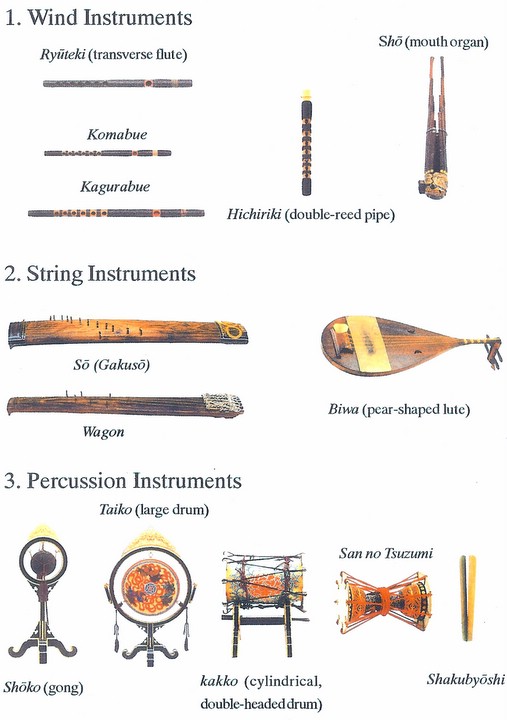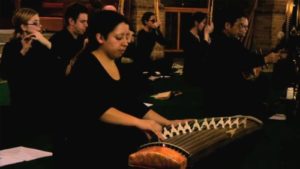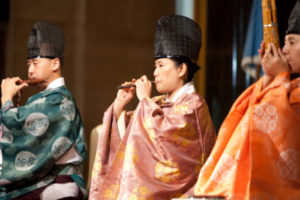As of September 2, 1996, Mr. Ted Mack, Program Administrator of the Institute, leaves us to pursue his doctorate at Harvard University in the field of Modern Japanese Literature. We will greatly miss him as a person and as a tireless worker far beyond the requirements of duty and we wish him all success in future. His e-mail address is emack@fas.harvard.edu.
This summer we were truly blessed to be able to recruit as our new full-time Program Administrator and Associate Director, Dr. Sadako Ohki, formerly of Cornell University. Dr. Ohki earned her B.A. in English and American Literature from Aoyama Gakuin University in Tokyo and her M.A. and Ph.D. in Japanese Art History from the University of Michigan. She is, as well, an expert in Japanese calligraphy and will play a major role in our ongoing Imperial Buddhist Convent Research Survey Project that is being conducted in Kyoto in cooperation with the National Institute of Japanese Literature. (Dr. Ohki’s report from the August 28-31, 1996 survey session at Hokyoji convent follows below.)
Anne Lazrove, Research Associate of the Institute for Medieval Japanese Studies, who has had long experience studying the history of Zen at Komazawa University, Tokyo, and currently, at Yale University, remains our point person in charge of the American side of the Institute’s Convent Project. Her specialization is especially valuable to the Convent Project, especially since those Convents currently being surveyed are Rinzai Zen convents.
Prof. X. Jie Yang of the University of Calgary, Canada, is a Research Associate of the Institute as well. Professor Yang, whose doctoral dissertation at Kyoto University was on Heike Monogatari and whose specialty is medieval literature, is a computer expert now developing methods to scan and project emaki, ehon and handwritten manuscripts by means of CD-ROM technology for both research and classroom teaching purposes. He is also developing a computer program for the teaching of sosho. All of these activities are of crucial importance to us as we attempt to manage and utilize the large number of materials emerging from the convent survey. Professor Komine Kazuaki of Rikkyo University, Tokyo, who was formally at the National Institute of Japanese Literature and was one of the ongoing members of my research group there that developed the Convent Survey Project, has now become a Research Associate of the Institute for Medieval Japanese Studies. His office at Rikkyo will serve as the Tokyo liaison for the Institute in matters concerning the Convent Survey.
We continue to welcome inquiries from scholars whose expertise and interests may lead them to want to join in some concrete way in this research undertaking.
Barbara Ruch
The Institute for Medieval Japanese Studies, founded in 1968, is an international liaison and research center designed primarily to serve European and American scholars whose main area of study focuses on medieval Japan. The overall purpose of the Institute is to encourage research on all aspects of Japanese civilization relative to the medieval period (the Kamakura and Muromachi periods, 1185-1600), centuries which, until the 1970’s, had been relatively neglected among Japanese and Western scholars alike. The facilities of the Institute are available to all scholars and students of medieval Japan from any academic institution.
Address letters of inquiry to:
Institute for Medieval Japanese Studies
Columbia University
406 Kent Hall
New York, N.Y. 10027
Director: Barbara Ruch
Associate Director: Dr. Sadako Ohki
Tel. (212) 854-7403
Fax. (212) 678-8629
ISSN 1058-9996
Report on the August 28-31, 1996, Dodo gosho Survey
In August 1996, shortly after joining the Institute for Medieval Japanese Studies as the new Associate Director, I was “sent to a nunnery”–not to become a nun, but to participate in the Institute’s Imperial Buddhist Convent Research Project to survey the unpublished documents preserved at Hokyoji convent in the northern central part of Kyoto. Despite the warning of the unbearable heat in Kyoto, particularly in temples and nunneries without air-conditioners, the weather was cool and pleasant, though wet with early autumn rain. The sheer fatigue I felt from sitting on the tatami mat at the convent all day and sleeping on the tatami mat (with futon of course) at night proved how “Americanized” my body had become since I came to the States. At the same time, however, the challenge also served to recharge my Japanese spirituality. The visit gave me the exciting opportunity to examine primary documents, to learn about Imperial convents, and to meet with hard-working Japanese scholars.
Together with two scholars from the local Kyoto area, Prof. Junko NISHIGUCHI of Soai University, and Prof. Yoshiko OKA of Otemae Women’s College, I participated in all of the four days of the survey, though I had to leave Friday afternoon for an appointment with Abbot Fukushima of the Tofukuji monastery, who has long been a patron of our survey project. Scholars from Tokyo and Yokohama managed to come in for two or three days despite their busy schedules. They were Prof. Kazuaki KOMINE of Rikkyo University, who is also a new Research Associate of the Institute for Medieval Japanese Studies; Prof. Rikizan ISHIKAWA of Komazawa University; Prof. Noriko KATSUURA of Tokyo Women’s College; and Mr. Shunsho MANABE, Associate Director & Curator of the Kanagawa Prefectural Kanazawa Bunko Museum.
The convent keeps many of its documents in “boxes.” On the first day (Aug. 28), we took a look at Box Five. We found letters, diaries, and account books. There were some notes and letters dated from the sixteenth century around Oda Nobunaga’s time (1534-82), but the majority of the documents came from the Edo period, the seventeenth through the nineteenth centuries. In addition, we found some unusual objects. One of them was zeichiku, the long, thin bamboo sticks that were used for divination. Another was instructional booklets on how to conduct and read divination. The most intriguing were the thin metal rings which looked like large bracelets, the purpose of which, at present, is unknown. Unfortunately, because of the overwhelming number of documents that needed to be classified within the given time, we split up the work and thus did not have the chance to familiarize ourselves with all of the documents. I will be better informed to report on the contents of Box Five when the consolidated list of items becomes ready sometime before the next survey, which is scheduled in December 1996. (We have added to this issue of IMJS Reports a list of the contents of Box Four from the March, 1996 survey for your information. See below.)
Despite the time constraint, I still made many interesting discoveries. For example, I learned that the name “Kin’nomiya-sama” appeared frequently in the letters someone else was assigned to examine. Kin’nomiya is Princess Kin (1824-42).
As many of you probably know, Hokyoji is known for its collection of dolls. When a young princess was sent to the nunnery, her family sent her exquisite dolls to assuage her homesickness. Princess Kin, for one, is known to have received a doll with long orange-red hair reminiscent of a kabuki actor. The doll is of the type called shojo ningyo, which was believed to fend off hoso (chicken pox). Moreover, through surveying many of the convent ‘s account books of revenues and expenditures from the early to mid-nineteenth century, I came across interesting terms such as “kachin” and “oman.” I later found out that “kachin” means “rice cake” and “oman” means “steamed bun with sweet bean paste filling.” These must have been the snacks that the nuns bought at nearby shops.
On the second day (Aug.29), the young nun at Hokyoji, called Eko-san (family name TANAKA), brought out another box of documents. This box (approximately 30x50x20 cm) contained various reference materials used by the nuns at the convent in the past. It included books useful for finding dates of aristocratic members, abbesses, and priests, as well as books on rules and regulations of annual observances at court (Nenjugyoji kojitsusho). It was also my delight to encounter Chiyono no soshi, an illustrated story in Nara ehon format which recounts the legendary story of the enlightenment experience of the Abbess Mugai Nyodai. Prof. Ruch had previously told me about her first encounter with this small booklet there and how much it excited her. It equally excited me.
The fourth and the last day (Aug. 31) of our survey was on Saturday. We conducted an oral history interview for the first time. The attendance by four female scholars, Prof. Nishiguchi, Prof. Oka, Prof. Katsuura, and me, seemed to convey a true female enthusiasm in this new undertaking. Prof. Nishiguchi was the leading interviewer, though we all participated in asking a few questions. Abbess Esai (family name SAWADA) at Hokyoji was kind enough to be interviewed for about an hour and a half. The younger Eko-san and the elderly long-time domestic helper Hiroe-san pitched in to give lively answers to our questions. It surprised us to see the three members of the nunnery talking, reminiscing, and even debating at times on subjects which apparently had not been discussed among themselves. It was as if we had provided for them an opportunity to recall their old times and ways. As the newest member of the convent, Eko-san was especially interested in learning about the formal and orthodox modes of conducting daily religious services. We had prepared many questions, but we realized that we had to limit our questions to only a few this time, and tried hard to understand clearly what they were trying to say. Prof. Nishiguchi is planning to make a written report on the outcome of this interview. The interview was recorded and we all took notes, but it was impossible to transcribe the taped interview because two or three different people sometimes talked at the same time. As the first round, the oral history interview was a valuable experience, but we all realized the need to reevaluate more fully the purpose and the methodology of researching the oral history of current elderly abbesses. -Sadako Ohki





 In conjunction with the Gagaku-Hōgaku Classical Japanese Music Curriculum and Performance Program at Columbia University, launched in September 2006, the Institute for Medieval Japanese Studies presents several public gagaku concerts and instrumental workshops to introduce the ancient music of Japan to a greater audience at Columbia University and in New York.
In conjunction with the Gagaku-Hōgaku Classical Japanese Music Curriculum and Performance Program at Columbia University, launched in September 2006, the Institute for Medieval Japanese Studies presents several public gagaku concerts and instrumental workshops to introduce the ancient music of Japan to a greater audience at Columbia University and in New York.